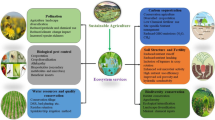Abstract
The success of an agricultural industry in commercial duck egg production in the swamplands of South Kalimantan (Borneo) is examined through the utilization of a human ecology framework. Seasonality of resource availability and human population growth are identified as two major constraints to production faced by farmers. Population increases in the urban sectors of southeastern Borneo also present economic opportunities for farmers because of the growing demand for poultry products. Farmers have responded by developing an intensification strategy in egg production based on the use of diversified resources for duck feed. The long-term consequences of these and other innovations in duck farming are discussed; and diversity-stability theory is examined for its applicability to this case of agricultural development and for rural development theory and practice.
Similar content being viewed by others
References
Ardi, I. (1982a).Informasi Aspek Non Harga Komuditi Peternakan Itik di Kabupaten Hulu Sungai Utara. Diskusi Proyek Pengembangan Sistim Informasi Pasar Priode I, Tahun Anggaran 1982/1983. Oktober 11, 1982, Amuntai.
Ardi, I. (1982b). Personal communication. Dinas Peternakan Dati II, Hulu Sungai Utara, Amuntai.
Bates, R. H. (1983). Some core assumptions in development economics.In Ortiz, S. (ed.),Economic Anthropology: Topics and Theories, University Press of America, Lanham, pp. 361–398.
Biro Pusat Statistik Kalimantan Selatan (1980).Registrasi Penduduk Propinsi Kalimantan Selatan Pertengahan Tahun 1980. Biro Pusat Statistik dan Kantor Statistik Propinsi Kalimantan Selatan, Banjarmasin.
Biro Pusat Statistik Kalimantan Selatan (1981).Penduduk Kabupaten Hulu Sungai Utara 1980. Hasil Pencacahan Lengkap. Biro Pusat Statistik Kalimantan Selatan, Banjarmasin.
Direktorat Jenderal Peternakan, Direktorat Bina Produksi, Departmen Pertanian (1979).Laporan Inventarisasi Masalah Tehnik Peternakan. Proyek Pengembangan Produksi Peternakan Pusat. Direktorat Jenderal Peternakan, Jakarta.
Friedman, J. (1974). Marxism, structuralism, and vulgar materialism.Man 9: 444–469.
Hetzel, J., Sutikno, I., dan Soeripto (1981). Beberapa pengaruh aflatoksin terhadap pertumbuhan itik-itik muda. Proceedings Seminar Penelitian Peternakan 1981, pp. 400–404.
Kabupaten Dati II, Hulu Sungai Utara, Propinsi Kalimantan Selatan (1980).Rencana Umum Kota amuntai. Kompilasi Data Buku II, Amuntai.
Kingston, D. J., Kosasih, D., and Ardi, I. (1979).The Rearing of Alabio Ducklings and the Management of the Laying Duck Flocks in the Swamps of South Kalimantan. Report No. 9, Centre for Animal Research and Development, Bogor.
Leiserson, M., Bose, S., Chandrasekaran, C., Cherniehovsky, D., Key, R., Meesook, O. A., and Suebsaeng, P. (1980).Employment and Income Distribution in Indonesia. A World Bank Country Study. The World Bank, Washington, D.C.
Lembaga Biologi Nasional (1978).Palem Indonesia. Proyek Sumber Day a Ekonomi, Lembaga Biologi Nasional-L.I.P.L, Bogor.
Margalef, D. R. (1968).Perspectives in Ecological Theory. University of Chicago Press, Chicago.
May, R. M. (1974). Ecosystem patterns in randomly fluctuating environments.Progress in Theoretical Biology 3: 1–50.
McCay, B. J. (1978). Systems ecology, people ecology, and the anthropology of fishing communities.Human Ecology 6: 397–422.
Mohr, E. C. H. (1945). Climate and soils in the Netherlands Indies.In Honig, P., and Verdoorn, F. (eds.),Science and Scientists in the Netherlands Indies. Board for the Netherland Indies, Surinam and Curacao, New York, pp. 250–262.
Murdoch, W. W., and Oates, A. (1975). Predation and population stability.Advances in Ecological Research 9: 1–31.
Odum, E. P. (1969). The strategy of ecosystem development.Science 164: 262–270.
Richerson, P. J. (1977). Ecology and human ecology: A comparison of theories in the biological and social sciences.American Ethnologist 4: 1–26.
Robequain, C. (1955).Malaya, Indonesia, Borneo and the Philippines: A Geographical, Economic and Political Description of Malaya, The East Indies, and the Philippines. John Wiley, New York.
Robinson, D. W., Usman, A., Dartojo, E., and Chavez, E. R. (1977).The Husbandry of Alabio Ducks in South Kalimantan Swamplands. Report No. 3, Centre for Animal Research and Development, Bogor.
Rotenberry, J. T. (1980). Dietary relationships among shrub-steppe passerine birds: Competition or opportunism in a variable environment.Ecol. Monogr. 50: 93–110.
Rungun, S. (1982).Interview. Dinas Peternakan Tingkat I. Kalimantan Selatan, Banjarbaru.
Siregar, A. P. (1982). Sejarah itik di Indonesia.Poultry Indonesia 26 (111/25): 35–36.
U.S.A.I.D. (1982). Agricultural briefing paper, Indonesia 1983. Office of Agricultural Development, U.S.A.I.D., Jakarta.
Vayda, A. P. (1979). Human ecology and economic development in Kalimantan and Sumatra.Borneo Research Bulletin 11: 23–32.
Vayda, A. P., and McCay, B. J. (1975). New directions in ecology and ecological anthropology.Annual Review of Anthropology 4: 293–306.
Vondal, P. J. (1984). Entrepreneurship in an Indonesian duck egg industry: A case of successful rural development. Unpublished doctoral dissertation in anthropology, Rutgers University, New Brunswick.
Wiens, J. A. (1984). On understanding a non-equilibrium world: Myth and reality in community patterns and processes.In Strong et al. (eds.),Ecological Communities: Conceptual Issues and the Evidence. Princeton University Press, Princeton, New Jersey, pp. 439–457.
Author information
Authors and Affiliations
Additional information
The research that this paper is based upon was funded by the National Science Foundation under Grant No. BNS-8107626, Cathay Pacific Airlines, and The Graduate School, Rutgers University, New Brunswick, New jersey. In Indonesia, the research was sponsored by Universitas Lambung Mangkurat, Banjarmasin, and Lembaga Ilmu Pengetahuan Indonesia (LIPI), Jakarta.
Rights and permissions
About this article
Cite this article
Vondal, P.J. Intensification through diversified resource use: The human ecology of a successful agricultural industry in Indonesian Borneo. Hum Ecol 15, 27–51 (1987). https://doi.org/10.1007/BF00891370
Issue Date:
DOI: https://doi.org/10.1007/BF00891370




